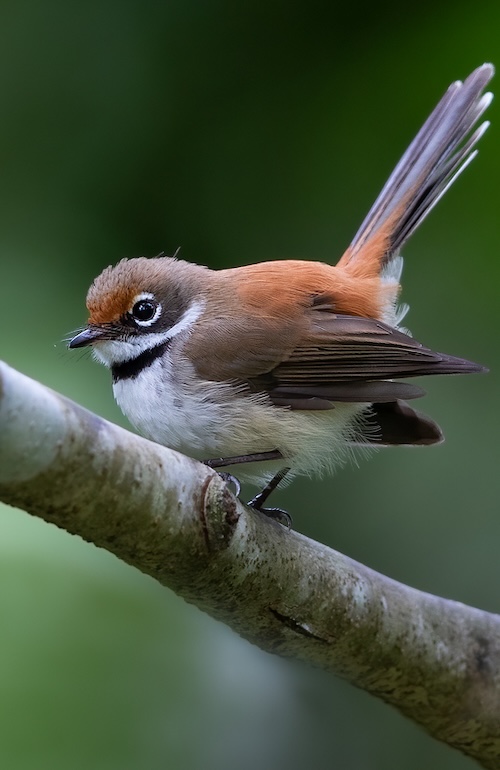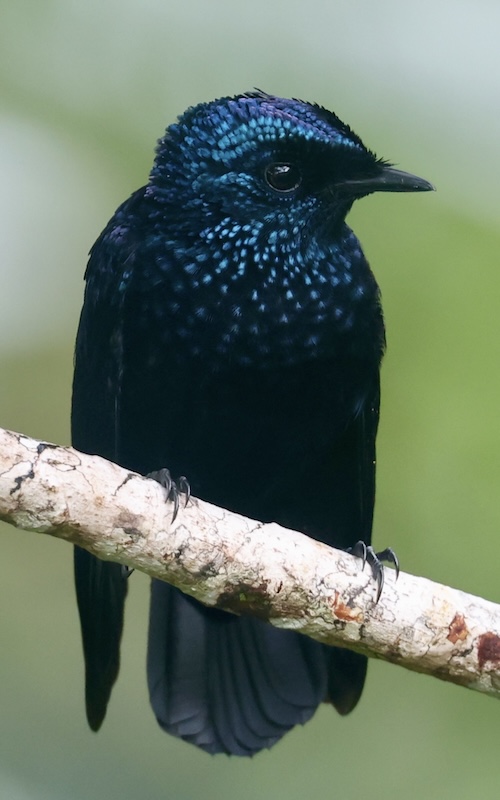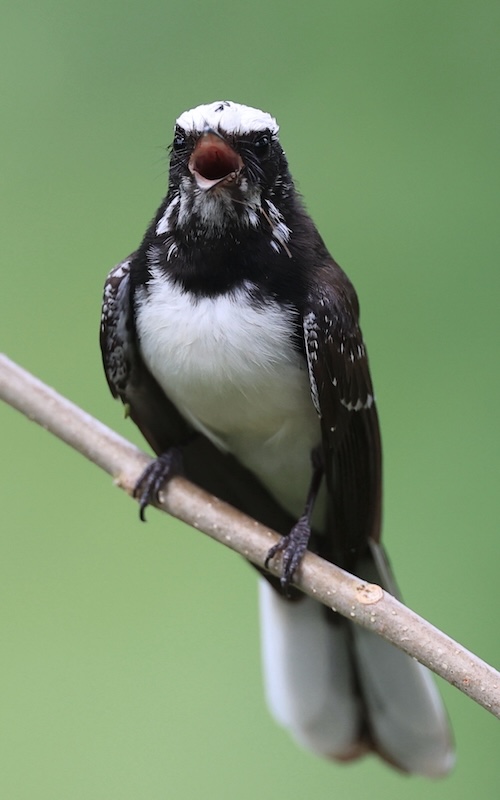Rhipiduridae – Fantails
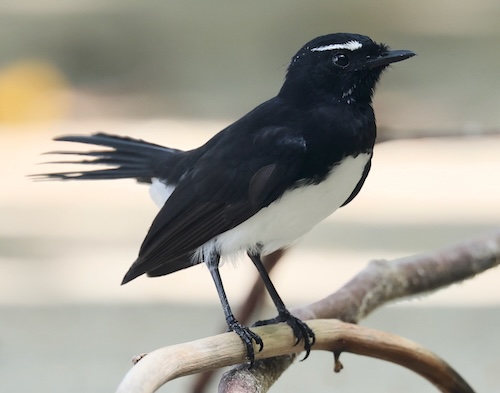
Rhipiduridae (Fantails) are sixty-five small insectivorous passerine family of Australasia, Southeast Asia and the Indian subcontinent, the majority (61) belong to the genus Rhipidura, with the rest in three small genera. Most of the species are about 15 to 18 cm long, specialist aerial feeders, and named as ‘fantails’.
However, the Willie Wagtail is a little larger, and, though still an expert hunter of insects on the wing, concentrates equally on terrestrial prey. (The true wagtails are part of the genus Motacilla in the family Motacillidae and are not close relatives of the fantails).
The majority are small bodied (11.5–21 cm long) birds with long tails; in some species the tail is longer than the body and in most the tail is longer than the wing. When the tail is folded it is rounded at the end, but when spread in display or aerial foraging it has a characteristic fan shape that gives the family its name.
|
|
|
|
Long-tailed Fantail Rhipidura opistherythra |
Supertramp Fantail Rhipidura semicollaris |
|
All photos on this page courtesy of ©Dubi Shapiro unless otherwise attributed |
|
Fantails adopt a hunched horizontal posture most of the time, with the wings drooped and held away from the body and the tail half cocked. There are some exceptions to this, particularly the Northern Fantail of New Guinea and the Cockerell’s Fantail of the Solomon Islands, which have a more upright posture reminiscent of the monarch flycatchers.
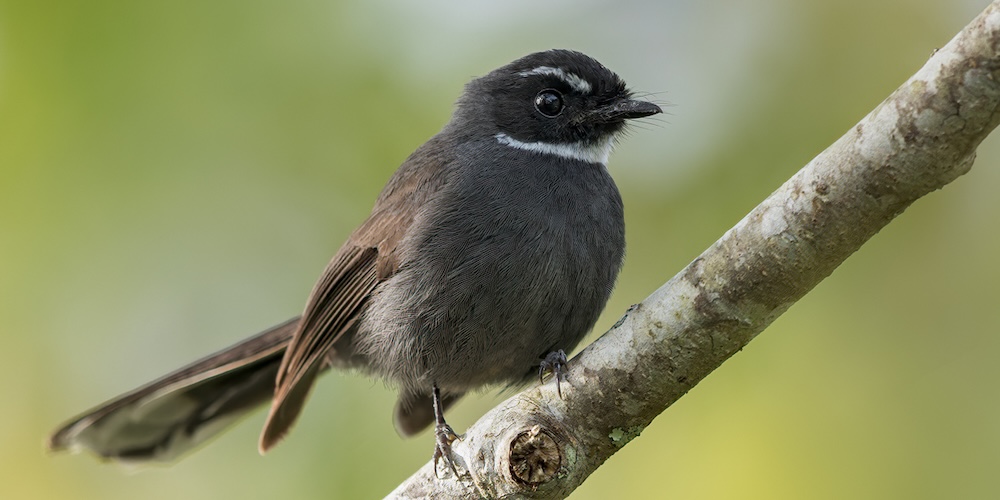
White-throated Fantail Rhipidura albicollis
The wings of fantails are tapered and have sacrificed speed for agility, making fantails highly efficient at catching insect prey. Overall, the fantails are strong fliers, and some species can undertake long migrations, but the thicket fantails (Sooty Thicket Fantail, White-bellied Thicket Fantail and Black Thicket Fantail) are very weak fliers, and need to alight regularly. Their bills are typical for aerial insect eating birds, being flat and triangular. The gape is surrounded by two rows of rictal bristles which are long, often as long as the bill. The bills of most species are fairly weak, limiting fantails to softer insects, although the more terrestrial Willie Wagtail has a stronger bill.
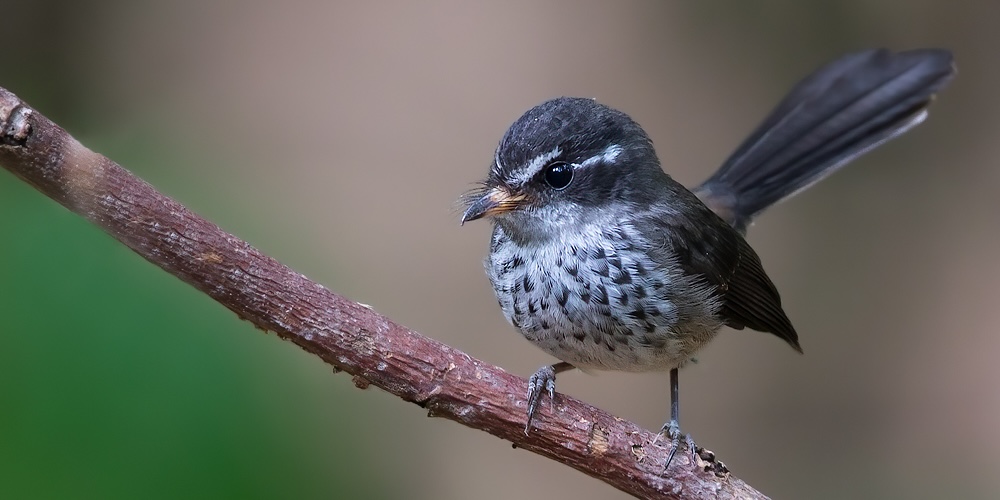
Vanuatu Streaked Fantail Rhipidura spilodera
The plumage of most fantails shows some variation; most species are relatively uniform with some markings. A few species, such as the Rennell Fantail, have uniform plumage, while others have striking if sombre patterns. The colours of most species are greys, blacks, whites and browns, although a few species have yellow or even striking blue feathers. In most species there is no sexual dimorphism in plumage; the notable exception being the Black Fantail of New Guinea where the male has all-over black plumage and the female is almost entirely rufous. In a few species, such as the New Zealand Fantail, there exist two colour morphs, the common pied morph and the rarer black morph (which is most common on the South Island).
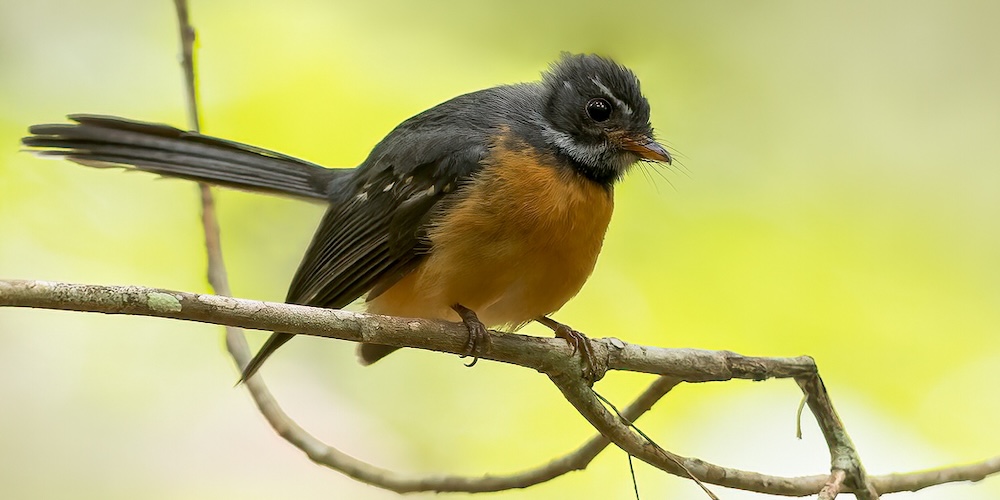
Chestnut-bellied Fantail Rhipidura hyperythra
Fantails are an Australasian family that has spread from as far as Samoa to northern India. In the south the Grey Fantail ranges as far as The Snares off New Zealand, in the eastern extent of the family has several endemic forms in western Polynesia. There are numerous species in Indonesia, the Philippines and in South East Asia, and the family ranges into southern China, India and the Himalayas. Some species have a widespread distribution, particularly the Willie Wagtail, Grey Fantail, White-throated Fantail and Northern Fantail; others have a highly restricted range and in the case of some insular species may be restricted to a single island. The Mussau Fantail is restricted to a single island in the Bismarck Archipelago, and the Kadavu Fantail has a similarly restricted distribution in the Kadavu Group of Fiji.
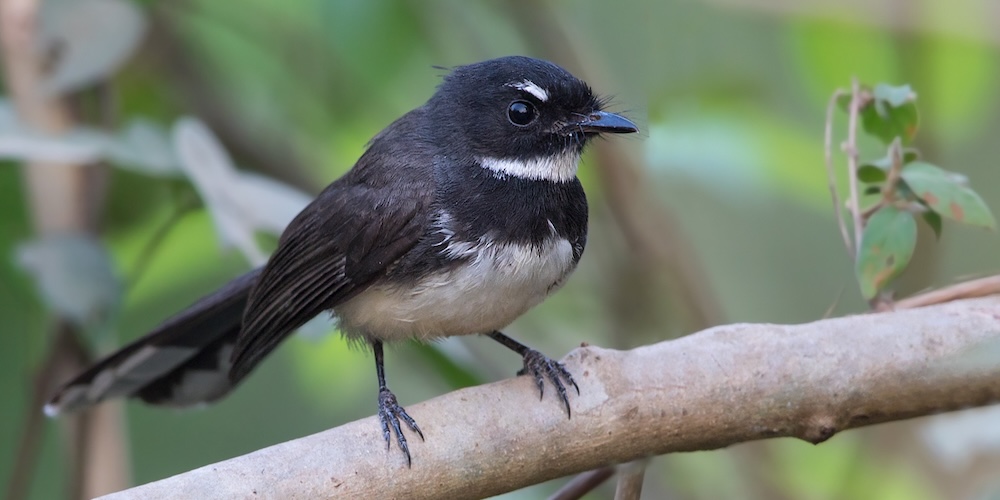
Malaysian Pied Fantail Rhipidura javanica
Fantails exhibit wide tastes in habitat; while the majority of species are found in rainforests, fantails exist in most available habitats from deserts and mangrove forests to highly modified agricultural and urban environments. Most species are able to survive in a variety of habitats.
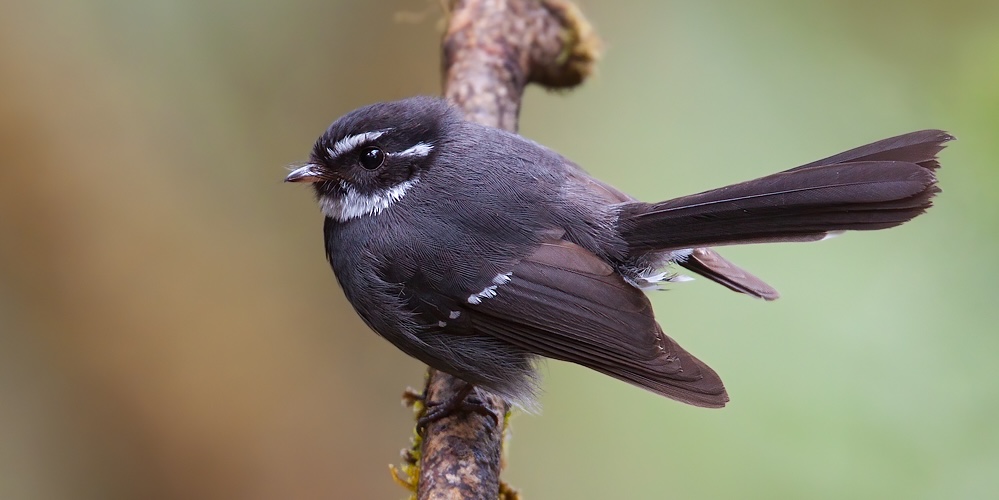
Friendly Fantail Rhipidura albolimbata
The behaviour of many species of fantail has not been studied, but overall, the family is highly uniform in its habits. Anecdotal observations of less studied species suggest a high degree of similarity with the better studied ones. Fantails are highly active birds, with several of the smaller species continuously on the move; even when perched they continue to rock back and forth, spin 180° on the spot, wag their tail from side to side or fan and re-furl it. In flight they are highly agile and undertake highly aerobatic and intricate looping flights while using their fanned tail to catch insects in flight.
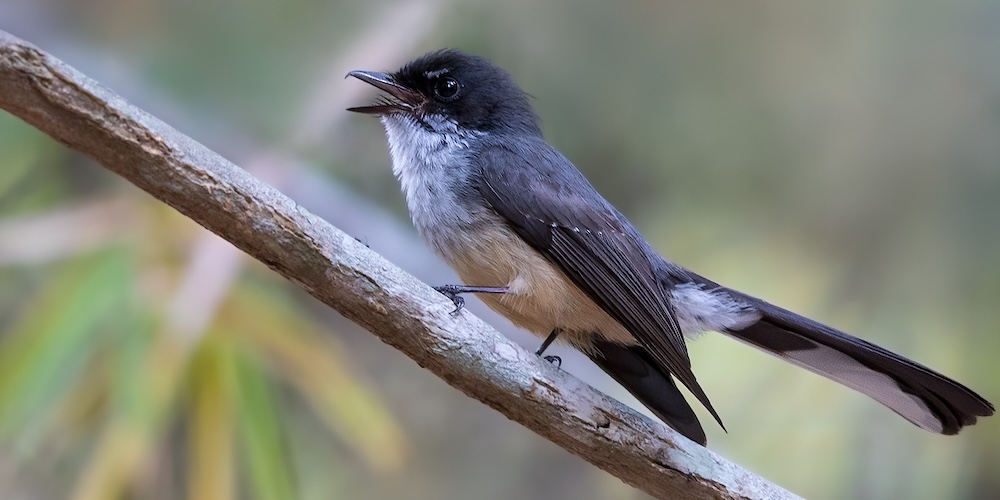
Northern Fantail Rhipidura rufiventris
These earth-coloured songbirds, with an eyestripe or throat-patch in most, are named for their habit of fanning their tails as they move actively along branches in Australasian and South Asian forests. This rapid opening and closing of the tail feathers reveal, then hide white tail-spots that are thought to startle insects into moving, revealing themselves and being captured by these quiet and generally inconspicuous birds. Most species are excellent aerial hunters as well.
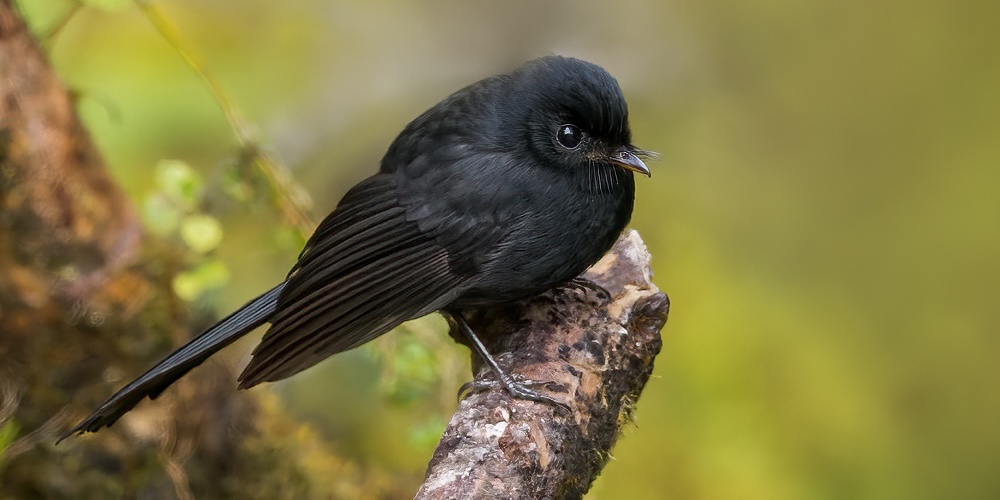
Black Fantail Rhipidura atra
Fantails frequently form associations with other species in order obtain prey. Some species perch on the backs of cattle, which they use both as a vantage point and because the cattle flush up insects. This behaviour has given the Willie Wagtail the nickname ‘shepherd’s companion’. Fantails are often very bold around people and will approach them closely in order to capture insects flushed by them. Different species are also frequently found in mixed-species feeding flocks, travelling with other small insectivorous birds on the periphery of the flocks taking advantage of flushed prey.
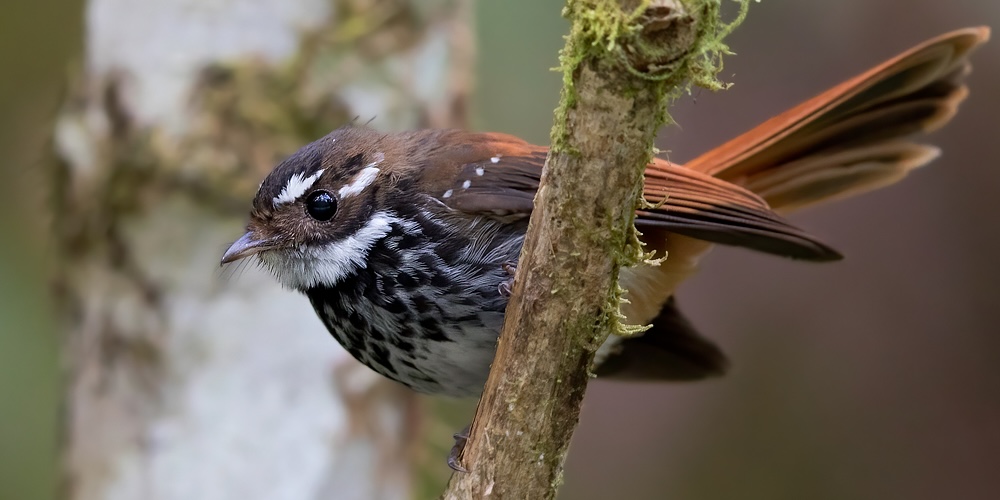
Streak-breasted Fantail Rhipidura dedemi
Fantails are territorial and aggressively defend their territories from conspecifics (other members of the same species) as well as other fantail species and other flycatchers. Within the territory the female selects the nesting site, these sites are often close to the previous year’s nest. Breeding responsibilities, nest building, incubation and chick feeding, are shared between both sexes.
|
|
|
| Taveuni Silktail Lamprolia victoriae |
White-browed Fantail Rhipidura aureola |
| Both above images courtesy of ©Nick Ludovic Green Bird-Photo-Tours ASIA | |
The nest, a small cup of grass stems neatly bound together in spider silk, takes around 10 days to construct. Many species incorporate a trailing tail into the base of the nest; this possibly breaks up the shape of the nest, although little other effort is made to conceal the nest. To compensate for the high visibility of the nest fantails will aggressively defend their chicks from potential predators.
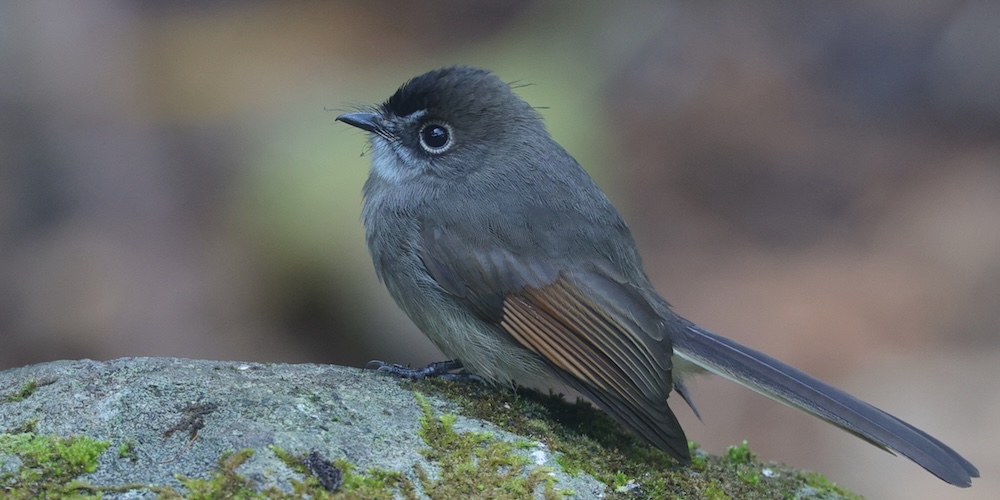
Brown-capped Fantail Rhipidura diluta – ©Nick Ludovic Green Bird-Photo-Tours ASIA
Female fantails will also distract a potential predator by appearing to be injured and luring the predator away from the nest. While the female is pretending to be injured the male may continue to attack the predator. In spite of this, fantails have a generally low nesting success.
-
Number of bird species: 65
(As at December 2025)
According to the recently (2025) amalgamated AviList, there are sixty-five species, in four genera in the Rhipiduridae family. They are:
Drongo Fantail Chaetorhynchus papuensis
Cerulean Flycatcher Eutrichomyias rowleyi
Taveuni Silktail Lamprolia victoriae
Natewa Silktail Lamprolia klinesmithi
Black Fantail Rhipidura atra
Black-and-cinnamon Fantail Rhipidura nigrocinnamomea
Mindanao Blue Fantail Rhipidura superciliaris
Visayan Blue Fantail Rhipidura samarensis
Tablas Fantail Rhipidura sauli
Visayan Fantail Rhipidura albiventris
Blue-headed Fantail Rhipidura cyaniceps
Spotted Fantail Rhipidura perlata
Cinnamon-tailed Fantail Rhipidura fuscorufa
Cockerell’s Fantail Rhipidura cockerelli
White-gorgetted Fantail Rhipidura coultasi
Northern Fantail Rhipidura rufiventris
Brown-capped Fantail Rhipidura diluta
Sooty Thicket Fantail Rhipidura threnothorax
Black Thicket Fantail Rhipidura maculipectus
White-bellied Thicket Fantail Rhipidura leucothorax
Willie Wagtail Rhipidura leucophrys
Malaysian Pied Fantail Rhipidura javanica
Philippine Pied Fantail Rhipidura nigritorquis
White-throated Fantail Rhipidura albicollis
White-spotted Fantail Rhipidura albogularis
Rufous-tailed Fantail Rhipidura phoenicura
White-bellied Fantail Rhipidura euryura
White-browed Fantail Rhipidura aureola
Rufous-backed Fantail Rhipidura rufidorsa
Dimorphic Fantail Rhipidura brachyrhyncha
Bismarck Fantail Rhipidura dahli
Mussau Fantail Rhipidura matthiae
Malaita Fantail Rhipidura malaitae
Rusty-bellied Fantail Rhipidura teysmanni
Peleng Fantail Rhipidura habibiei
Taliabu Fantail Rhipidura sulaensis
Tawny-backed Fantail Rhipidura superflua
Streak-breasted Fantail Rhipidura dedemi
Long-tailed Fantail Rhipidura opistherythra
Palau Fantail Rhipidura lepida
Manus Fantail Rhipidura semirubra
Supertramp Fantail Rhipidura semicollaris
Arafura Fantail Rhipidura dryas
Gilolo Fantail Rhipidura torrida
Rufous Fantail Rhipidura rufifrons
Louisiade Fantail Rhipidura louisiadensis
Santa Cruz Fantail Rhipidura melanolaema
Micronesian Rufous Fantail Rhipidura versicolor
Solomons Rufous Fantail Rhipidura rufofronta
Pohnpei Fantail Rhipidura kubaryi
Friendly Fantail Rhipidura albolimbata
Chestnut-bellied Fantail Rhipidura hyperythra
Brown Fantail Rhipidura drownei
Bourgainville Fantail Rhipidura drownei
Guadalcanal Fantail Rhipidura ocularis
Vanuatu Streaked Fantail Rhipidura spilodera
Fiji Streaked Fantail Rhipidura layardi
New Caledonia Streaked Fantail Rhipidura verreauxi
Makira Fantail Rhipidura tenebrosa
Rennell Fantail Rhipidura rennelliana
Kadavu Fantail Rhipidura personata
Samoan Fantail Rhipidura nebulosa
Grey Fantail Rhipidura albiscapa
Mangrove Fantail Rhipidura phasiana
New Zealand Fantail Rhipidura fuliginosa
-
Rhipiduridae
Family AccountThese earth-colored songbirds, with an eyestripe or throat-patch in most, are named for their habit of fanning their tails as they move actively along branches. -
Rhipiduridae
Family AccountThe family Rhipiduridae are small insectivorous birds of Australasia, Southeast Asia and the Indian subcontinent that includes the fantails and silktails.
Given the number of species in this family, Fatbirder does not provide quick links to all of them. However, the entries below do include links to representatives of every genera, all those illustrated and some of the most often encountered, iconic or sought-after species.
-
Black Fantail Rhipidura atra
Species AccountThe black fantail (Rhipidura atra) is a species of bird in the family Rhipiduridae. -
Black Fantail Rhipidura atra
Species AccountSound archive and distribution map -
Brown-capped Fantail Rhipidura diluta
Species AccountThe brown-capped fantail (Rhipidura diluta) is a species of bird in the family Rhipiduridae. It is found in the Lesser Sunda Islands (Sumbawa and Flores). -
Brown-capped Fantail Rhipidura diluta
Species AccountSound archive and distribution map -
Cerulean Flycatcher Eutrichomyias rowleyi
Species AccountAn unmistakable, fairly large blue flycatcher confined to Sangihe island. -
Cerulean Flycatcher Eutrichomyias rowleyi
Species AccountSound archive and distribution map -
Chestnut-bellied Fantail Rhipidura hyperythra
Species AccountA fairly small, long-tailed bird of forest midstory from the lowlands to the lower mountains. -
Chestnut-bellied Fantail Rhipidura hyperythra
Species AccountThe chestnut-bellied fantail (Rhipidura hyperythra) is a species of bird in the family Rhipiduridae. -
Chestnut-bellied Fantail Rhipidura hyperythra
Species AccountSound archive and distribution map -
Drongo Fantail Chaetorhynchus papuensis
Species AccountSound archive and distribution map -
Drongo Fantail Chaetorhynchus papuensis
Species AccountThe drongo fantail (Chaetorhynchus papuensis), also known as the pygmy drongo, is a species of passerine bird endemic to the island of New Guinea. -
Friendly Fantail Rhipidura albolimbata
Species AccountSound archive and distribution map -
Friendly Fantail Rhipidura albolimbata
Species AccountA fairly small, long-tailed bird of montane forest and edge. -
Grey Fantail Rhipidura fuliginosa
Species AccountThe Grey Fantail is most easily recognised by its constantly fanned tail and agile aerial twists and turns. Both sexes are similar in appearance: grey above, with white eyebrow, throat and tail edges. This species is quite inquisitive and will closely approach an observer… -
Grey Fantail Rhipidura fuliginosa
Species AccountSound archive and distribution map -
Long-tailed Fantail Rhipidura opistherythra
Species AccountThe long-tailed fantail (Rhipidura opistherythra) is a species of bird in the family Rhipiduridae. -
Long-tailed Fantail Rhipidura opistherythra
Species AccountSound archive and distribution map -
Malaysian Pied Fantail Rhipidura javanica
Species AccountThe Malaysian pied fantail (Rhipidura javanica) is a species of bird in the fantail family and one of 47 species in the genus Rhipidura. It is locally referred to as murai gila, literally "crazy thrush" in the Malay language.[2] It is found in Brunei, Cambodia, Indonesia, Laos, Malaysia, Myanmar, Singapore, Thailand, and Vietnam. Its natural habitat is subtropical or tropical moist lowland forests. -
Malaysian Pied Fantail Rhipidura javanica
Species AccountSound archive and distribution map -
New Zealand Fantail Rhipidura fuliginosa
Species AccountSound archive and distribution map -
New Zealand Fantail Rhipidura fuliginosa
Species AccountThe New Zealand fantail (Rhipidura fuliginosa) is a small insectivorous bird. A common fantail found in the South Island of New Zealand, also in the North Island as subspecies Rhipidura fuliginosa placabilis, the Chatham Islands as Rhipidura fuliginosa penita and formerly (now extinct) the Lord Howe Island as Rhipidura fuliginosa cervina. Also known as the pied fantail (pied morph only) or by its Maori name, Pīwakawaka, Tīwakawaka or Piwaiwaka. -
New Zealand Fantail Rhipidura fuliginosa
Species AccountThe fantail is one of New Zealand’s best known birds, with its distinctive fanned tail and loud song, and particularly because it often approaches within a metre or two of people. Its wide distribution and habitat preferences, including frequenting well-treed urban parks and gardens, means that most people encounter fantails occasionally. -
Northern Fantail Rhipidura rufiventris
Species AccountThe northern fantail (Rhipidura rufiventris) is a species of bird in the family Rhipiduridae. It is found in New Guinea, Timor, and northern Australia... -
Northern Fantail Rhipidura rufiventris
Species AccountSound archive and distribution map -
Streak-breasted Fantail Rhipidura dedemi
Species AccountA little rufous songbird with a long broad tail, often held cocked and habitually fanned. Rufous above with a darker pale-tipped tail. -
Streak-breasted Fantail Rhipidura dedemi
Species AccountSound archive and distribution map -
Supertramp Fantail Rhipidura semicollaris
Species AccountSmall island specialist; a "classic" fantail, with long, pale-tipped tail and slim bill. -
Supertramp Fantail Rhipidura semicollaris
Species AccountSound archive and distribution map -
Taveuni Silktail Lamprolia victoriae
Species AccountSound archive and distribution map -
Taveuni Silktail Lamprolia victoriae
Species AccountThe Taveuni silktail (Lamprolia victoriae) is a species of bird endemic to Fiji. -
Vanuatu Streaked Fantail Rhipidura spilodera
Species AccountSmall, with a long, often fanned tail. Gray above with a brownish back, speckled white chest, and elegant white eyebrow and cheek stripe. -
Vanuatu Streaked Fantail Rhipidura spilodera
Species AccountSound archive and distribution map -
White-browed Fantail Rhipidura aureola
Species AccountFantail with a broad white eyebrow, dark upperparts, and white underparts. Crown and ear-coverts black, contrasting with white eyebrows. -
White-browed Fantail Rhipidura aureola
Species AccountSound archive and distribution map -
White-throated Fantail Rhipidura albicollis
Species AccountA distinctive fantail, all dark except for a white throat and a short white eyebrow. -
White-throated Fantail Rhipidura albicollis
Species AccountSound archive and distribution map -
Willie Wagtail Rhipidura leucophrys
Species AccountLarge black-and-white songbird with fine bill and long legs. -
Willie Wagtail Rhipidura leucophrys
Species AccountSound archive and distribution map


